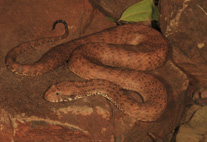Abstract
Australian death adders (genus Acanthophis) are highly venomous snakes with conservative morphology and sit-and-wait predatory habits, with only moderate taxonomic diversity that nevertheless remains incompletely understood. Analyses of mitochondrial and nuclear gene sequences and morphological characteristics of death adders in northern Australia reveal the existence of a new species from the Kimberley region of Western Australia and the Northern Territory, which we describe as Acanthophis cryptamydros sp. nov. Although populations from the Kimberley were previously considered conspecific with Northern Territory death adders of the A. rugosus complex, our mtDNA analysis indicates that its closest relatives are desert death adders, A. pyrrhus. We found that A. cryptamydros sp. nov. is distinct in both mtDNA and nDNA analysis, and possesses multiple morphological characteristics that allow it to be distinguished from all other Acanthophis species. This study further supports the Kimberley region as an area with high endemic biodiversity.

